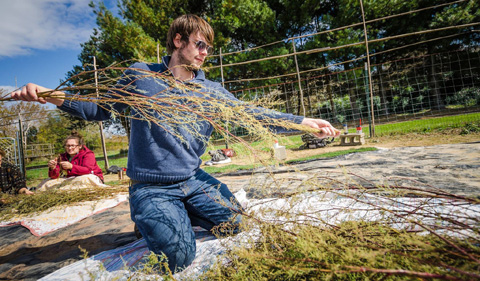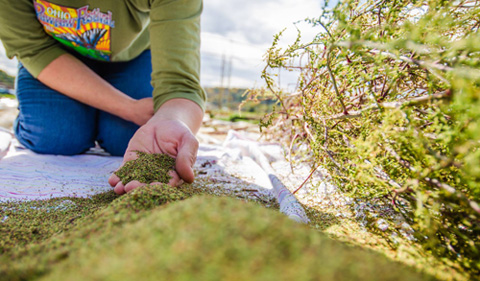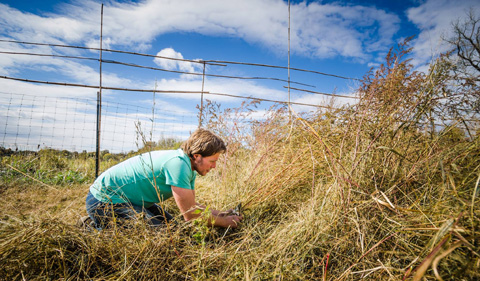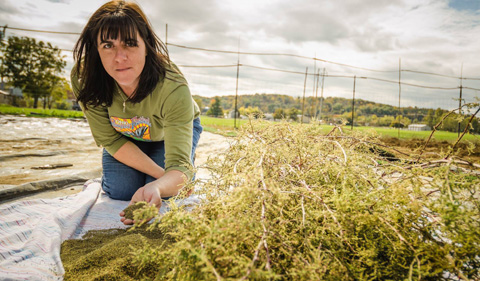By Cameron Fortin ’16
On a brisk autumn morning, Ohio University students, staff, faculty, and supporters enthusiastically met at the research gardens on West State Street to harvest a plant viewed by most Ohioans as a weed.
It fed Ohio Valley residents more than 3,000 years ago, and it has potential to become a sustainable food source—and to relieve pressure on its popular relative quinoa.
Arguably not much to look at, and growing inconspicuously in disturbed roadside soil, pitseed goosefoot (Chenopodium berlandieri)—or colloquially, chenopods—has not often garnered much attention— academically nor publicly. However, this plant has an essentially identical, high profile cousin, South American quinoa (Chenopodium quinoa).
Dr. Paul Patton, Assistant Professor of Anthropology, with the support of curious students and community members, has been able to generate some excitement around the possibility of a vegetarian-beloved quinoa analog, equal (if not greater) in protein to its southern relative, that can grow abundantly in the Appalachian hills of southern Ohio. The planting of chenopod stands earlier this spring, and now its harvest, has been carried out as a collaboration between the Sociology & Anthropology Department, the Food Studies theme, and the Environmental & Plant Biology Department.
What They Were Eating in Southeastern Ohio 3,000 Years Ago
While the propagation of chenopods on an industrial scale is a new and exciting endeavor, the cultivation of this remarkable seed is by no means a new phenomenon. In fact, the dietary use of these protein-packed seeds is over 4,000 years old! Patton, whose research specialization is in archaeobotany, has recently discovered evidence of domesticated chenopods in the Hocking Valley over 3,000 years ago.
“We believe that the original domestication of chenopods took place in the Illinois River valley region, but spread rather quickly to southeastern Ohio,” says Patton. “This was the major food crop in Eastern North America before maize and it fed numerous Native American communities throughout the Appalachian region. We are still in the developing stages of this project, but there’s no reason to think that this plant can’t once again make a healthy contribution to the human diet.”
For the indigenous populations who once inhabited the Ohio River Valley, this plant was an essential food resource. Chenopods were one of the key components of what is known as the Eastern Agricultural Complex, the original suite of plants domesticated before the introduction of maize to the region. Archaeological data suggests that the dispersed populations of small-scale horticulturalists who built the large earthworks, which have come to symbolize these cultures, were sustained by EAC species, including the nutrient rich chenopods.

Anthropology alum Michael Pistrui ’13, now a library staff member in preservation, threshes chenopods by hand.
Ancient native food may hold potential for relieving food insecurity
Much as the ancient Ohio peoples known as Adena and Hopewell cultivated chenopods to supplement their foraged diet, the production and distribution of this plant today could potentially supplement the demand for South American quinoa, allowing for some of the economic pressure to be taken off of the Andean peoples who often can no longer afford their own crop. This has caused alarm among those concerned with sustainability. The greater Athens area has increasingly becoming known as a hotspot of the local food movement. From the annual Pawpaw Festival devoted to the celebration of a quirky fruit, to the 30 Mile Meal initiative uniting local entrepreneurs in the goal of food sustainability, this region is ripe for the emergence of new sustainable crops.
The research into Chenopodium berlandieri is a one part of the many exciting developments in the realm of food studies at Ohio University. This is an exciting step forward that all community members should continue to keep an eye on.
Contact Paul Patton at pattonp@ohio.edu or Theresa Moran at morant@ohio.edu for more information.






















5 Comments